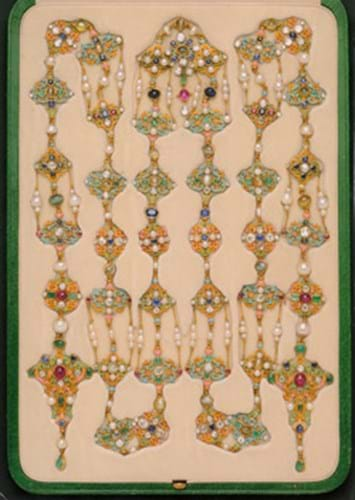
The chain was made and signed by Tiffany and Co and was one of nine lots sold by direct descendants of William Walters (1819-1894) and his son Henry (1848-1931), wealthy collectors of paintings and decorative arts.
Henry Walters bequeathed the family collection to the city of Baltimore whose celebrated museum is named in their honour. Henry's enthusiasm for art dates back to an adolescence spent in Paris. Along with Impressionist painting, Old Masters and a wide range of ancient art, it extended to more modern decorative arts including creations by the likes of Fabergé, Lalique and Tiffany whom he began to patronize in the early 1890s.
The 4ft 10in (1.50m) long chain comprises a series of scrolling foliate enamel links set with cabochon rubies, chrysoberyl, sapphires and old cut diamonds. It was created to a Renaissance-inspired design by Paulding Farnham, the man who won the New York firm world-wide plaudits when he revolutionised Tiffany's output in jewellery and silver design.
According to the museum records, Henry Walters purchased this chain for a relative who would appear to be his sister Jennie Walters (1853-1922), later Delano, to whom he was very close.
The chain has since passed down to her descendants. Skinner believe the cerulian blue enamel employed to such striking effect on the chain links suggests it was created around the same time as the so-called Holbein pendant, another revivalist jewel shown by Farnham at the 1901 Pan-American exhibition in Buffalo.
This would make it one of the last major pieces he designed before he resigned from the company in the early years of the 20th century after Louis Comfort Tiffany took over.
Contained in a signed fitted case it was, said Skinner's specialist Gloria Lieberman, in "extraordinary condition considering the delicacy of the enamel". She added: "Many of our clients felt it was possibly the most significant piece of American jewellery to come fresh to the market with extraordinary provenance in 20 years".
That opinion was endorsed by the price. A dozen bidders including institutions, collectors and dealers were in the fray to secure it ensuring the $75,000-125,000 estimate was easily outstripped with the hammer falling final to an anonymous "non-trade" purchaser at $350,000 (£269,230) plus premium.
More on the Walters' and other antique jewels in Skinner's sale in a future issue.
By Anne Crane




